Operation Brünnhilde: evacuation of the German 17th Army from Taman
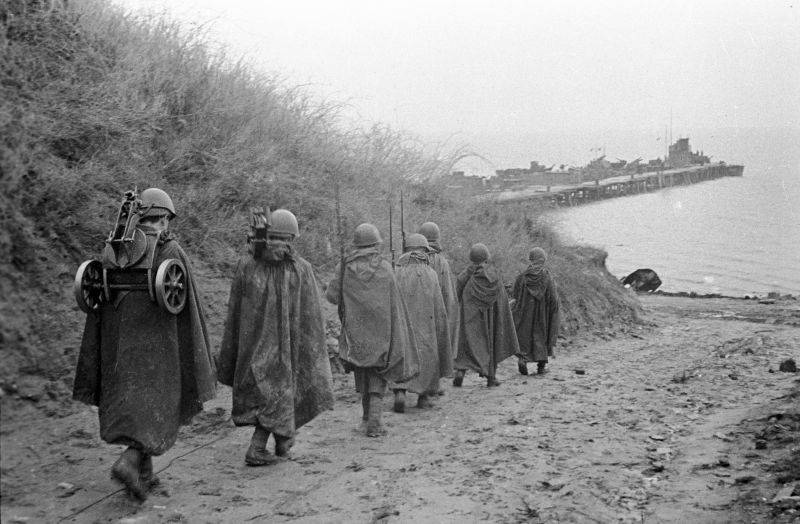
A unit of Red Army soldiers goes to the pier on the Taman Peninsula
Fall of the Blue Line
Successful Novorossiysk operation (Storm of the Blue Line) was decisive in the liberation of the Taman Peninsula. The advance of the troops of the 18th Army in the direction of Anapa and the landing of amphibious assault forces on the flanks of the German troops began to threaten the entire Taman group of the Wehrmacht (17th Army).
The German command, with the help of the well-fortified Blue Line, sought to hold the Taman bridgehead. The Wehrmacht needed Taman to cover the approaches to the Crimean Peninsula from the Kerch Strait and to constrain the actions of the Soviet Black Sea fleet and large forces of the Red Army. However, the Germans prepared in advance the Krimgild plan for the systematic evacuation of troops from the Taman Peninsula to Crimea.
The fall of the Novorossiysk fortress forced the Nazis to change their plan and launch Operation Brunnhilde - an accelerated evacuation of troops. Already on September 11, 1943, the chief of staff of Army Group A informed the head of the operational department of the ground forces that it was unlikely that it would be possible to dislodge Russian troops from Novorossiysk. The German command begins a hasty withdrawal of troops.
The command of the North Caucasus Front (NCF), in order to speed up the liberation of Novorossiysk and tie up the forces of the enemy army, on September 11 ordered the 9th and 56th armies to go on the offensive. On the morning of September 12, the 9th Army under the command of Grechkin launched attacks in the direction of Keslerovo, Kalabatka and Red October. The Germans occupied strong positions on the heights here.
The stubborn battle continued for four days on the outskirts of Keslerovo. On September 16, units of the 389th Infantry Division under the command of Colonel Kolobov made their way into the village. The enemy threw reserves into battle, concentrated in the area of Kievskoye, Varenikovskaya, Gladkovskaya. This facilitated the offensive of the 18th Army in the Novorossiysk area.
On September 14 at 7 o'clock, after a 40-minute artillery barrage, Grechko's 56th Army went on the offensive. It delivered the main blow in the areas: Kievskoye, Moldavanskoye and Nizhnebakansky. During the first day the army advanced only 800–1 meters. This was due to the powerful defense of the enemy, there were almost continuous minefields, the Germans fired heavy artillery and mortars and launched counterattacks. On September 000, Soviet troops made virtually no progress. Progress was measured literally in meters.
On the same day, the German command gave the order to begin the systematic withdrawal of troops of the 17th Army of the right wing and center from the Blue Line line. The retreat was covered by strong rearguards. At night, Grechko’s army regrouped its forces and occupied the central section of the Blue Line on September 16. Soviet troops captured the main centers of enemy resistance - Kiev, Moldavian and Neberdzhaevskaya. By the end of the day, Grechko’s army reached the line Melnichny, Trudovoy, Prokhladny, Nizhnegrechesky and Amanat.
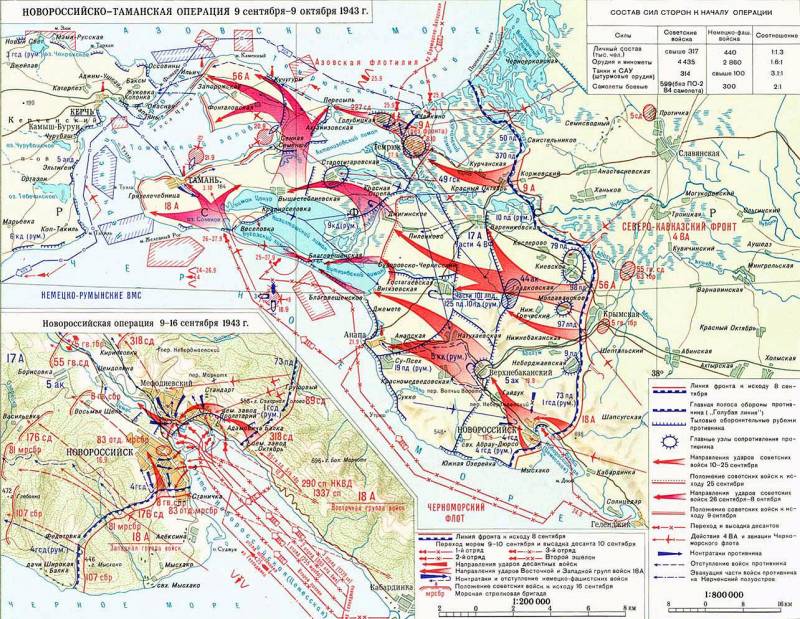
Retreat of the 17th Army
On September 17, 1943, German troops tried to stabilize the situation and launched a strong counterattack in the Keslerovo area. They were even able to recapture the village. They could no longer restore the situation, since Kievskoye was already occupied by units of the 56th Army. On September 18, the Germans were again driven out of Keslerovo. The Nazis repelled attacks by Soviet troops for three days, relying on the second defensive line. The 9th Army was able to capture bridgeheads on the left bank of the Adagum River, but did not achieve success at the turn of the river. The trigger is in the direction of the main strike. Meanwhile, units of Leselidze’s 18th Army advanced 15–16 km and liberated Gaiduk, Vladimirovka, Glebovka, South Ozereyka, and the Abrau-Durso state farm.
The German command is accelerating the withdrawal of troops. In intermediate positions, strong resistance was provided by reinforced rearguards. The Wehrmacht acted skillfully and effectively. The German maneuvers were facilitated by the terrain. Between numerous estuaries and lakes there were strong natural boundaries, where the Germans destroyed communication routes and mined approaches. A small force could hold back the advance of a larger enemy.
Soviet troops were forced to take each such line in battle while the main enemy forces were retreating. Engineering units played a major role in such a war. German sappers destroyed communications, created rubble, and mined everything they could. Our sappers cleared the area and discovered enemy mine traps.
Along the way, the Nazis traditionally used scorched earth tactics, which greatly delayed ours. Transport and industrial infrastructure, all important structures and facilities were destroyed. Food was exported and livestock was stolen. Hitler's special directive stated:
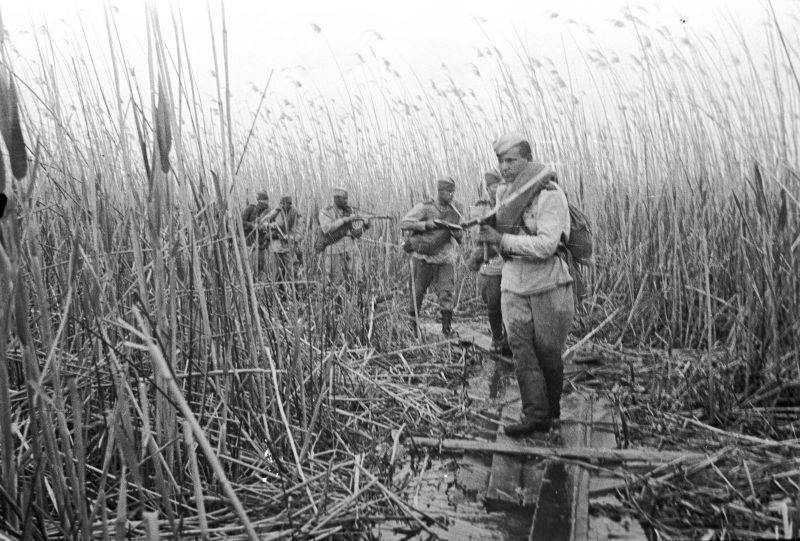
Soviet machine gunners pass through the Kuban flood plains.
On September 19, units of the 56th Army liberated several settlements. On this day, stubborn battles took place on the approaches to the village of Varenikovskaya, where Sergatskov’s 22nd Rifle Corps was advancing. The Germans tried to stop the Soviet offensive to ensure the withdrawal of the forces of the 9th, 79th and 98th Infantry and 97th Light Infantry Divisions.
Varenikovskaya was well fortified, covered with wire fences and continuous minefields. At the heights south of Varenikovskaya and in the forest on the western bank of the river, the enemy concentrated a significant amount of firepower. The defensive system included small water barriers on the approaches to the village. The Nazis concentrated troops on both sides of the highway passing through the village.
The Germans repelled the attack of the 22nd Rifle Corps from the front. The corps regrouped to bypass the village from the south. The scouts studied the front line and the location of fire weapons, and the sappers made passages in the enemy's minefields and obstacles. At 24 hours on September 21, after an hour of artillery preparation, the 22nd Corps again went on the offensive. Units of the 351st Rifle Division under the command of Colonel Vorozhishchev launched a flank attack, overcame water obstacles to the side of the highway and broke into Varenikovskaya. The Germans launched a counterattack, trying to dismember the battle formations of our troops, but they were driven back. By morning the village was completely liberated. The Germans lost about 800 people, a lot of equipment and weapons.
At the same time, the strike force of the 9th Army, consisting of units of the 316th, 304th and 276th rifle divisions, again went on the offensive. On the night of September 19, Soviet troops crossed the floodplains of the river using assault bridges set up in advance by sappers, and in some places by swimming. trigger and immediately broke through the German defense. By the end of the day, the strongholds of Kalabatka and Red October were captured, and Grechkin’s army reached the village of Kurchanskaya. The next day, Soviet soldiers liberated the village of Kurchanskaya.
In the offensive zone of the 18th Army, particularly stubborn battles took place on the distant approaches to Anapa. This port was a naval base for the German army, connecting it with Crimea. Here the Germans covered themselves with minefields; the mining density reached 2,5 thousand mines per 1 km. The Nazis fought especially fiercely for the mountainous areas near the village of Verkhnebakanskaya and on the Wolf Gate pass. The Wolf Gate Pass was of great operational importance, since most mountain roads crossed here. The Germans reinforced natural obstacles with artificial barriers.
With the help of powerful aviation and artillery strikes, Soviet troops overcame this strong defensive line. The tanks of the 5th Guards Tank Brigade quickly liberated the village of Raevskaya, opening a direct path to Anapa. Sappers made passages in the minefields and established their boundaries. Therefore, the tankers, practically without stopping, reached Anapa on September 21 and immediately burst into the city.
At the same time, ships of the Black Sea Fleet raided the port of Anapa, destroying part of the enemy fortifications. With the onset of darkness, Soviet ships again burst into the port, fired at enemy firing points and landed troops.
Tankers and marines almost simultaneously burst into Anapa. The Nazis were unable to provide long-term resistance. On September 21, Soviet troops liberated Anapa and captured significant trophies, including 40 warehouses with military equipment, 41 guns, 77 mortars, etc.
On September 24, Grechkin’s army reached the village of Gostagaevskaya. Units of the 242nd Mountain Rifle Division under the command of Colonel Lisinov defeated the German garrison, destroying up to a battalion of the enemy. The army's left flank reached the Vityazevsky estuary. The Germans continued to stubbornly resist, but no longer had time to take out all the equipment, supplies and property. Some of them were destroyed, some were simply abandoned.
The 56th Army pushed the enemy back across the river. Old Kuban and reached the next German defensive line, which ran between the Akhtanizovsky, Starotitarovsky and Kiziltashsky estuaries. Here the German defensive line had to be taken by frontal attacks.
At the same time, Leselidze’s army reached the village of Blagoveshchenskaya. Here the offensive was led by the 89th Rifle Division and the 55th Guards Irkutsk Division. Simultaneously with the frontal attack, it was decided to land two troops:
1) tactical landing in the Blagoveshchenskaya area;
2) the main landing in the area of Lake Solenoye to capture Taman.
The entire landing force numbered more than 8 thousand people. To complete the task, the fleet allocated more than 60 ships, boats and boats.
Due to stormy weather, the landing was delayed. The first to land a tactical landing force was in the area west of Blagoveshchenskaya - it included the 166th Guards Regiment of the 55th Guards Rifle Division and the 143rd Marine Battalion. In total, by the evening of September 25, more than 800 people had been disembarked. The patrol boats supported the landing with their fire. On the night of September 26, the main landing force was landed in the area of Lake Solenoye as part of the 83rd Marine Rifle Brigade. The sailors fought all day in the area of Salt Lake, but were unable to break through the enemy’s defenses.
The front command transferred additional forces to this area. The transfer of the 103rd and 8th Guards Rifle Brigades began. On September 27, Soviet troops launched an offensive towards Taman. By this time, the auxiliary landing force, in cooperation with units of the 55th Guards Division and the 5th Guards Tank Brigade, had liberated the village of Blagoveshchenskaya.
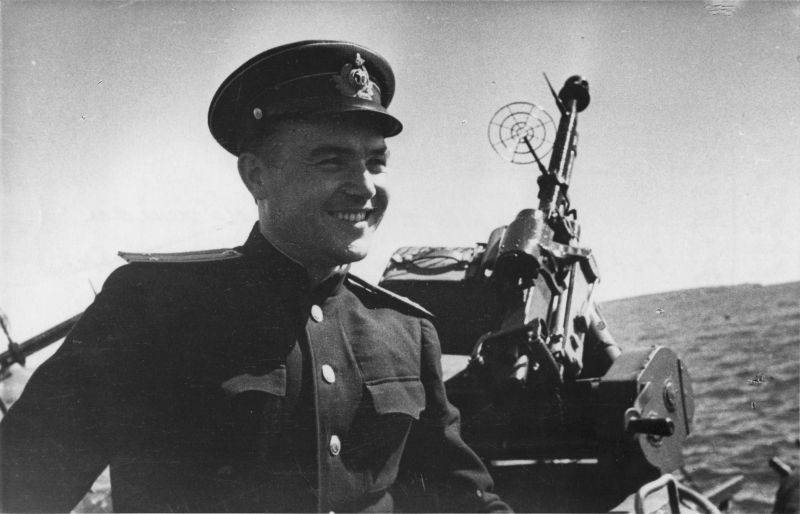
Commander of the 2nd brigade of torpedo boats of the Black Sea Fleet, captain 2nd rank Viktor Trofimovich Protsenko against the background of a DShK machine gun mounted on the G-5 boat
Liberation of Taman
Units of the 9th Army developed an offensive along the Kurchansky Estuary towards Temryuk. Temryuk was a powerful center of resistance and closed the left flank of the Blue Line. In addition, Temryuk was an important communications hub. The approach to it from the east and south was covered by estuaries and floodplains. The Germans reinforced natural obstacles with wire fences and minefields. The terrain made it difficult to employ large masses of troops using heavy weapons and equipment. As part of the 9th Army, small special detachments were formed that had independent missions.
Grechkin's army reached Temryuk. In order to accelerate the fall of Temryuk, it was decided to land troops in two places: the main one in the area east of Golubitskaya, and the auxiliary one in the Chaikino area. About 45 ships and vessels were involved in the landing.
On September 25, the main landing began - it included the 545th Infantry Regiment of the 389th Infantry Division. The paratroopers penetrated the enemy's coastal defenses, occupied the north-eastern part of Golubitskaya and cut the Temryuk-Peresyp road. The Germans launched strong counterattacks from the Peresyp area. The paratroopers took up a perimeter defense east of Golubitskaya and repelled enemy attacks, preventing the Germans from retreating from Temryuk. The auxiliary landing force, which included the 369th Separate Marine Battalion, also operated successfully. The Marines landed in the Chaikino area and, despite significant losses, assisted in the capture of Temryuk.
On the night of September 27, units of the 11th Rifle Corps, after powerful air and artillery preparation, broke into the eastern outskirts of the city. At the same time, part of the forces on boats crossed the Kurchansky estuary and attacked the enemy from the west. The Germans retreated to Golubitskaya. But having met Soviet paratroopers, they had to flee to the village of Starotitarovskaya. By the morning of September 27, Temryuk was completely liberated.
Aviation played a major role in the liberation of Temryuk and the landing operation, which effectively supported Soviet troops from the air. Aviation also interfered with the evacuation of the Nazis. The planes attacked concentrations of enemy forces on the roads, at loading points on ships and during the crossing to the Crimea. During these days, the aircraft of the 4th Air Army made up to 1 sorties, sank about 800 enemy ships, and seriously damaged about 150. The aviation of the Black Sea Fleet also operated effectively. From September 60 to 20, Black Sea Fleet aircraft shot down 28 German aircraft and sank about 56 ships.
The German command, trying to gain time, tried with all its might to delay the Soviet offensive. Using a significant reduction in the front, the Germans were able to leave large forces - the 370th, 79th and 98th infantry divisions - for defense at the Golubitskaya, Krasnaya Strela, Starotitarovskaya line. The 50th German Infantry, 19th Romanian Infantry and 4th Mountain Rifle Divisions occupied the defensive line of Akhtanizovskaya, Vyshesteblievskaya, Veselovka.
On October 2, the 56th Army broke through the German defenses between the Akhtanizovsky and Kiziltashsky estuaries and reached Starotitarovskaya. The enemy fiercely counterattacked, trying to restore the situation with the support of armored vehicles and powerful artillery and mortar fire. Our infantry, with the support of self-propelled guns, repelled enemy counterattacks. Grechko's army captured Starotitarovskaya. Having broken through the German defenses, Soviet troops captured the village of Vyshesteblievskaya and turned north, striking in the rear of the German troops who were holding back the advance of the 9th Army. The Germans hastily abandoned Akhtanizovskaya and retreated to Kuchugury, where another auxiliary defense line was located. After this, the Soviet command ordered the 9th Army to be withdrawn to the front reserve.
At the same time, troops of the 18th Army pursued the enemy along the southern coast of the Taman Peninsula. Veselovka and Taman were liberated. Troops of the 56th Army broke through the last German defensive line in the area of the village of Sennaya in a night assault.
On October 8, there were battles to capture the last strongholds of the German troops - Kuchugury, Fontalovskaya and Tatarsky. The 56th Army cut up the German group, reaching west of Kuchugur and Zaporizhzhya into the enemy’s flank and rear. The Germans quickly began to retreat to the Chushka Spit. By dawn on October 9, Soviet troops broke through German positions on the approaches to the spit and reached the Kerch Strait. The Nazis who did not have time to evacuate were destroyed.
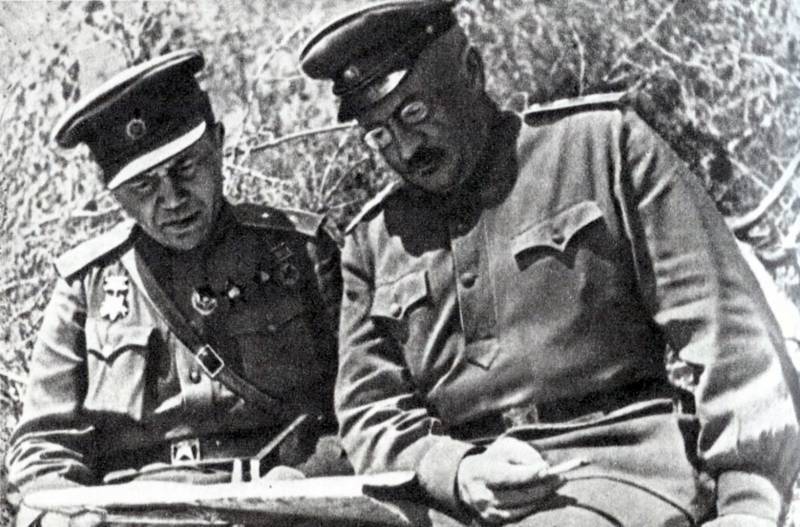
Commander of the troops of the North Caucasus Front I. E. Petrov (right) and artillery commander A. K. Sivkov. Taman Peninsula, 1943
Results
The operation was completed. On October 9, 1943, at 22 p.m., Moscow saluted the valiant SCF troops and naval formations that liberated the Taman Peninsula with 20 artillery salvoes from 224 guns. Many units and formations of the front and the Black Sea Fleet received the honorary names of Novorossiysk, Anapa, Kuban and Temryuk for their exploits.
The Red Army completed the liberation of the North Caucasus and liberated Novorossiysk and the Taman Peninsula. The enemy Kuban bridgehead, which relied on the powerful Blue Line, was destroyed. Now the Black Sea Fleet has the opportunity to operate more effectively along the sea communications of the Crimean enemy group. Favorable circumstances were created for the future liberation of Crimea.
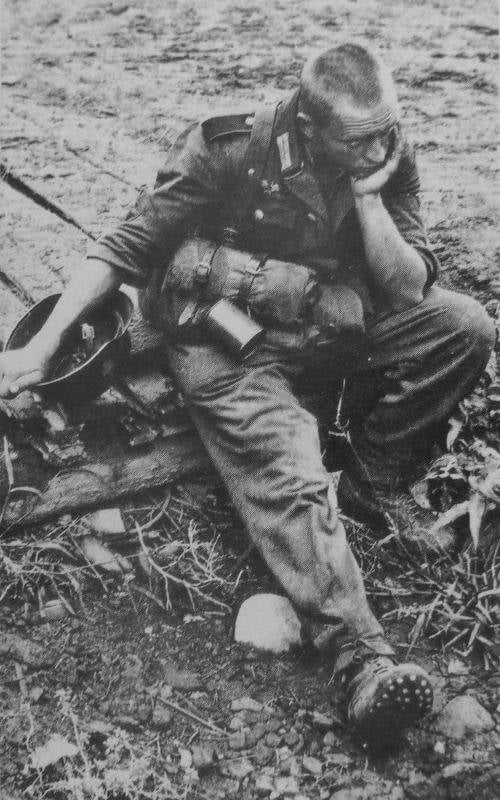
Portrait of a German soldier taken during the battles for the Caucasus. Post-war title of the photograph: “What are we actually fighting for?” The title also appears: “What is the point of this massacre?”
During this operation, Soviet soldiers broke through the powerful Blue Line, fought over 150 km, and defeated 8 German and 4 Romanian divisions. The Germans lost more than 36 thousand people killed, about 22 thousand wounded, 4 thousand prisoners, not counting those sunk and destroyed at crossings.
Partisans played a significant role in the operation. They carried out about 500 combat and sabotage operations, more than 300 reconnaissance operations, destroyed up to 100 bridges and crossings behind enemy lines, defeated 15 headquarters, 27 enemy garrisons and 15 police detachments, and carried out more than 100 raids on rear columns.
At the same time, the Germans were still a strong and skilled enemy. The Nazis were able to withdraw the main forces of the 17th Army under the cover of rearguards. After the breakthrough of the Blue Line, it was not possible to encircle and destroy most of the enemy forces, the offensive resulted in the pursuit and squeezing out of an orderly retreat of the enemy. The German command successfully evacuated the defeated units of the 17th Army through the Kerch Strait on ships and planes. Thus, strengthening our grouping on this section of the front. This was due to command and intelligence errors, as well as the complexity of the terrain.
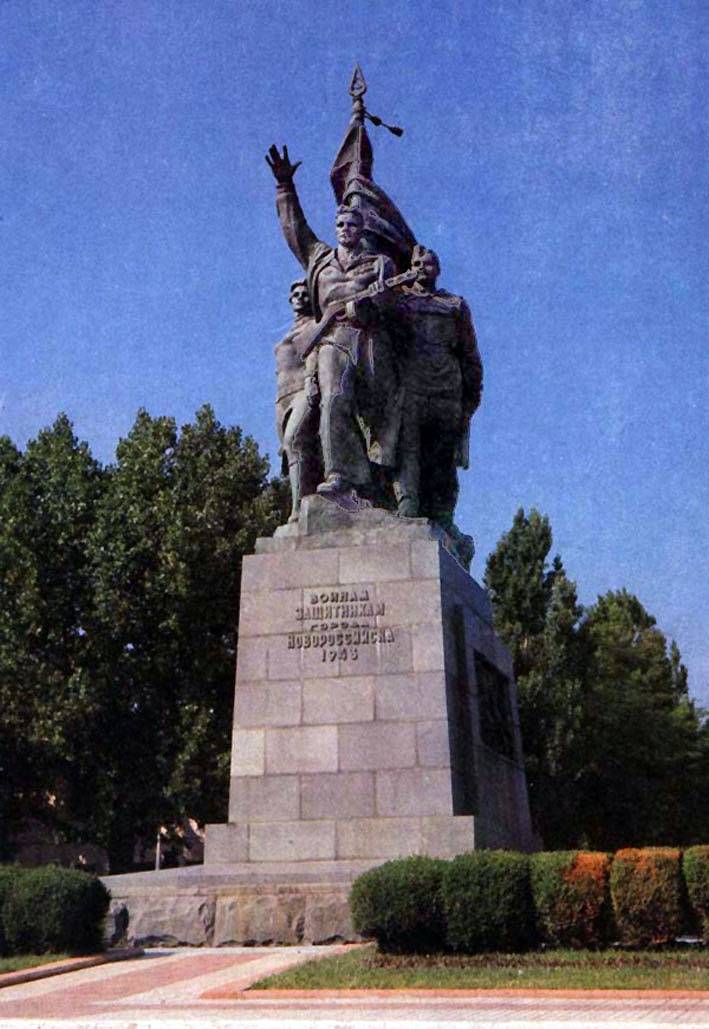
Monument to the Warriors - Defenders of the City of Novorossiysk. Sculptors I. P. Shmagun and N. Timoshin. Architects K. M. Mikhailov and E. G. Lashuk. Opened in 1961
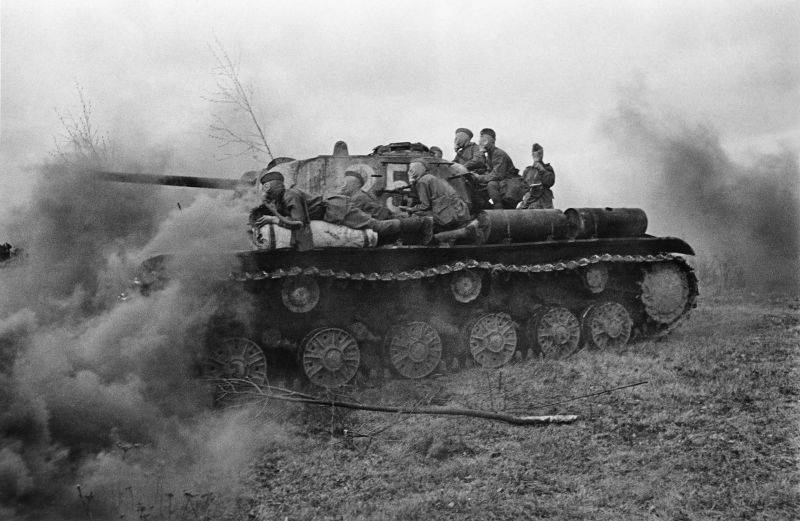
Information